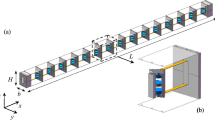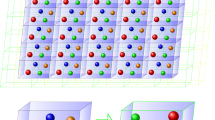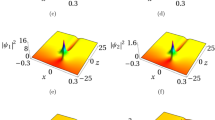Abstract
The cellular microstructure of periodic architected materials can be enriched by local intracellular mechanisms providing innovative distributed functionalities. Specifically, high-performing mechanical metamaterials can be realized by coupling the low-dissipative cellular microstructure with a periodic distribution of tunable damped oscillators, or resonators, vibrating at relatively high amplitudes. The benefit is the actual possibility of combining the design of wave-stopping bands with enhanced energy dissipation properties. This paper investigates the nonlinear dispersion properties of an archetypal mechanical metamaterial, represented by a one-dimensional lattice model characterized by a diatomic periodic cell. The intracellular interatomic interactions feature geometric and constitutive nonlinearities, which determine cubic coupling between the lattice and the resonators. The non-dissipative part of the coupling can be designed to exhibit a softening or a hardening behavior, by independently tuning the geometric and elastic stiffnesses. The nonlinear wavefrequencies and waveforms away from internal resonances are analytically determined by adopting a perturbation technique. The employed approach makes use of tools borrowed from Hamiltonian perturbation theory, together with techniques often used in the context of nearly-integrable Hamiltonian systems.The dispersion spectra are determined in closed, asymptotically approximate, form as a nonlinear function of the time-dependent decreasing amplitude decrement. The invariant manifolds defined by the harmonic periodic motions are also analytically determined. The asymptotic results are further validated numerically.











Similar content being viewed by others
Data availability statement
Relevant data can be made available upon request.
Notes
Knowingly, a sufficient and necessary condition of canonicity is that the Jacobian matrix of the transformation is symplectic.
References
Hussein, M.I., Frazie, M.J.: Metadamping: an emergent phenomenon in dissipative metamaterials. J. Sound Vib. 332(20), 4767–4774 (2013)
Friedrich, K., Breuer, U.: Multifunctionality of Polymer Composites: Challenges and New Solutions. Elsevier, Amsterdam (2015)
Ferreira, A.D.B., Nóvoa, P.R., Marques, A.T.: Multifunctional material systems: a state-of-the-art review. Compos. Struct. 151, 3–35 (2016)
Lincoln, R.L., Scarpa, F., Ting, V.P., et al.: Multifunctional composites: a metamaterial perspective. Multifunct. Mater. 2(4), 043001 (2019)
Arena, A., Taló, M., Snyder, M.P., et al.: Enhancing flutter stability in nanocomposite thin panels by harnessing CNT/polymer dissipation. Mech. Res. Commun. 104, 103495 (2020)
Arena, A., Lacarbonara, W.: Piezoelectrically induced nonlinear resonances for dynamic morphing of lightweight panels. J. Sound Vib. 498, 115951 (2021)
Talò, M., Lanzara, G., Krause, B., et al.: “Sliding Crystals’’ on low-dimensional carbonaceous nanofillers as distributed nanopistons for highly damping materials. ACS Appl. Mater. Interfaces 11(41), 38147–38159 (2019)
Formica, G., Lacarbonara, W.: Asymptotic dynamic modeling and response of hysteretic nanostructured beams. Nonlinear Dyn. 99, 227–248 (2020)
Schaedler, T.A., Carter, W.B.: Architected cellular materials. Ann. Rev. Mater. Res. 46, 187–210 (2016)
Kadic, M., Milton, G.W., van Hecke, M., et al.: 3D metamaterials. Nat. Rev. Phys. 1, 198–210 (2019)
Wang, Y.-F., Wang, Y.-Z., Wu, B., et al.: Tunable and active phononic crystals and metamaterials. Appl. Mech. Rev. 72(4), 040801 (2020)
Cummer, S.A., Christensen, J., Alù, A.: Controlling sound with acoustic metamaterials. Nat. Rev. Mater. 1(3), 1–13 (2016)
Bacigalupo, A., Lepidi, M.: Acoustic wave polarization and energy flow in periodic beam lattice materials. Int. J. Solids Struct. 147, 183–203 (2018)
D’Alessandro, L., Ardito, R., Braghin, F., et al.: Low frequency 3D ultra-wide vibration attenuation via elastic metamaterial. Sci. Rep. 9(1), 1–8 (2019)
Dal Corso, F., Tallarico, D., Movchan, N.V., et al.: Nested Bloch waves in elastic structures with configurational forces. Philos. Trans. R. Soc. A 377(2156), 20190101 (2019)
Fang, L., Darabi, A., Mojahed, A., et al.: Broadband non-reciprocity with robust signal integrity in a triangle-shaped nonlinear 1D metamaterial. Nonlinear Dyn. 100, 1–13 (2020)
Meng, H., Huang, X., Chen, Y., et al.: Structural vibration absorption in multilayered sandwich structures using negative stiffness nonlinear oscillators. Appl. Acoust. 182, 108240 (2021)
Zhu, H.-P., Chen, H.-Y.: Parameter modulation of periodic waves and solitons in metamaterials with higher-order dispersive and nonlinear effects. Nonlinear Dyn. 104(2), 1545–1554 (2021)
Wang, C., Kanj, A., Mojahed, A., et al.: Wave redirection, localization, and non-reciprocity in a dissipative nonlinear lattice by macroscopic Landau-Zener tunneling: Theoretical results. J. Appl. Phys. 129(9), 095105 (2021)
Askari, M., Hutchins, D.A., Thomas, P.J., et al.: Additive manufacturing of metamaterials: a review. Addit. Manuf. 36, 101562 (2020)
Deymier, P.A.: Acoustic Metamaterials and Phononic Crystals, Volume 173 of Springer Series in Solid-State Sciences. Springer-Verlag, Berlin Heidelberg (2013)
Lepidi, M., Bacigalupo, A.: Wave propagation propertiesof one-dimensional acoustic metamaterials with nonlinear diatomic microstructure. Nonlinear Dyn. 98(4), 2711–2735 (2019)
Vadalà, F., Bacigalupo, A., Lepidi, M., et al.: Free and forced wave propagation in beam lattice metamaterials with viscoelastic resonators. Int. J. Mech. Sci. 193, 106129 (2021)
Bacigalupo, A., Gambarotta, L.: Dispersive wave propagation in two-dimensional rigid periodic blocky materials with elastic interfaces. J. Mech. Phys. Solids 102, 165–186 (2017)
Beli, D., Arruda, J.R.F., Ruzzene, M.: Wave propagationin elastic metamaterial beams and plates with interconnected resonators. Int. J. Solids Struct. 139, 105–120 (2018)
Deng, B., Wang, P., He, Q., et al.: Metamaterials with amplitude gaps for elastic solitons. Nat. Commun. 9, 1–9 (2018)
Carboni, B., Lacarbonara, W.: Nonlinear dynamic response of a new hysteretic rheological device: experiments and computations. Nonlinear Dyn. 83, 23–39 (2016)
Casalotti, A., Lacarbonara, W.: Tailoring of pinched hysteresis for nonlinear vibration absorption via asymptotic analysis. Int. J. Non-Linear Mech. 94, 59–71 (2017)
Casalotti, A., El-Borgi, S., Lacarbonara, W.: Metamaterial beam with embedded nonlinear vibration absorbers. Int. J. Non-Linear Mech. 98, 32–42 (2018)
Muhammad, Lim, C.W., Li, J.T.H., et al.: Lightweight architected lattice phononic crystals with broadband and multiband vibration mitigation characteristics. Extreme Mech. Lett. 41, 100994 (2020)
Wu, L., Geng, Q., Li, Y.-M.: A locally resonant elastic metamaterial based on coupled vibration of internal liquid and coating layer. J. Sound Vib. 468, 115102 (2020)
Manimala, J.M., Sun, C.: Microstructural design studies for locally dissipative acoustic metamaterials. J. Appl. Phys. 115(2), 023518 (2014)
Bacigalupo, A., Gnecco, G., Lepidi, M., et al.: Computational design of innovative mechanical metafilters via adaptive surrogate-based optimization. Comput. Methods Appl. Mech. Eng. 375, 113623 (2021)
Lepidi, M., Bacigalupo, A.: Multi-parametric sensitivity analysis of the band structure for tetrachiral acoustic metamaterials. Int. J. Solids Struct. 136–137, 186–202 (2018)
Kochmann, D.M., Hopkins, J.B., Valdevit, L.: Multiscale modeling and optimization of the mechanics of hierarchical metamaterials. MRS Bull. 44, 773–781 (2019)
Zhou, J., Dou, L., Wang, K., et al.: A nonlinear resonator with inertial amplification for very low-frequency flexural wave attenuations in beams. Nonlinear Dyn. 96, 647–665 (2019)
Lepidi, M., Bacigalupo, A.: Nonlinear dispersion properties of acoustic waveguides with cubic local resonators. In: Developments and Novel Approaches in Biomechanics and Metamaterials, pp. 377–392. Springer, New York (2020)
Bukhari, M., Barry, O.: Spectro-spatial analyses of a nonlinear metamaterial with multiple nonlinear local resonators. Nonlinear Dyn. 99, 1539–1560 (2020)
Xu, L., Rahmani, M., Powell, D.A., et al.: Nonlinear Metamaterials, pp. 55–79. Springer International Publishing, Cham (2020)
Nayfeh, A.H., Mook, D.T.: Nonlinear oscillations. Wiley, New York, US (2008)
Fronk, M.D., Leamy, M.J.: Internally resonant wave energy exchange in weakly nonlinear lattices and metamaterials. Phys. Rev. E 100, 032213 (2019)
Settimi, V., Lepidi, M., Bacigalupo, A.: Nonlinear dispersion properties of one-dimensional mechanical metamaterials with inertia amplification. Int. J. Mech. Sci. 201, 106461 (2021)
Vakakis, A.F., King, M.E.: Nonlinear wave transmission in a monocoupled elastic periodic system. J. Acoust. Soc. Am. 98(3), 1534–1546 (1995)
Vakakis, A.F., King, M.E.: Resonant oscillations of a weaklycoupled, nonlinear layered system. Acta Mech. 128(1–2), 59–80 (1998)
Manktelow, K., Leamy, M.J., Ruzzene, M.: Multiple scales analysis of wave-wave interactions in a cubically nonlinear monoatomic chain. Nonlinear Dyn. 63, 193–203 (2011)
Silva, P.B., Leamy, M.J., Geers, M.G.D., et al.: Emergent subharmonic band gaps in nonlinear locally resonant metamaterials induced by autoparametric resonance. Phys. Rev. E 99(6), 063003 (2019)
Wattis, J.A.D.: Quasi-continuum approximations to lattice equations arising from the discrete nonlinear telegraph equation. J. Phys. A Math. Gen. 33(33), 5925 (2000)
Bacigalupo, A., Gambarotta, L.: Generalized micropolar continualization of 1D beam lattices. Int. J. Mech. Sci. 155, 554–570 (2019)
Bacigalupo, A., Gambarotta, L., Lepidi, M.: Thermodynamically consistent non-local continualization for masonry-like systems. Int. J. Mech. Sci. 205, 106538 (2021)
Porubov, A.: Wave modulation in a nonlinear acoustic metamaterial. Int. J. Non-Linear Mech. 137, 103788 (2021)
Mojahed, A., Vakakis, A.F.: Certain aspects of the acoustics of a strongly nonlinear discrete lattice. Nonlinear Dyn. 99, 643–659 (2020)
Romeo, F., Rega, G.: Propagation properties of bi-coupled nonlinear oscillatory chains: analytical prediction and numerical validation. Int. J. Bifurc. Chaos 18(7), 1983–1998 (2008)
Lazarov, B.S., Jensen, J.S.: Low-frequency band gaps inchains with attached non-linear oscillators. Int. J. Non-Linear Mech. 42(10), 1186–1193 (2007)
Sridhar, A., Kouznetsova, V.G., Geers, M.G.D.: A general multiscale framework for the emergent effective elastodynamics of metamaterials. J. Mech. Phys. Solids 111, 414–433 (2018)
Narisetti, R.K., Leamy, M.J., Ruzzene, M.: A perturbation approach for predicting wave propagation in one-dimensional nonlinear periodic structures. J. Vib. Acoust. 132(3), 031001 (2010)
Narisetti, R., Ruzzene, M., Leamy, M.J.: A perturbation approach for analyzing dispersion and group velocities in two-dimensional nonlinear periodic lattices. J. Vib. Acoust. 133(6), 061020 (2011)
Fang, X., Wen, J., Yin, J., et al.: Wave propagation in nonlinear metamaterial multi-atomic chains based on homotopy method. AIP Adv. 6(12), 121706 (2016)
Fang, X., Wen, J., Yin, J., et al.: Broadband and tunable one-dimensional strongly nonlinear acoustic metamaterials: theoretical study. Phys. Rev. E 94(5), 052206 (2016)
Fortunati, A., Wiggins, S.: Integrability and strong normal forms for non-autonomous systems in a neighbourhood of an equilibrium. J. Math. Phys. 57(9), 092703 (2016)
Fortunati, A., Wiggins, S.: A Lie transform approach to the construction of Lyapunov functions in autonomous and non-autonomous systems. J. Math. Phys. 60(8), 082704 (2019)
Poincaré, H.: Les Méthodes Nouvelles de la Mécanique Céleste. Gauthier-Villars, Paris (1892)
Eliasson, L.H.: Absolutely convergent series expansions for quasi periodic motions. Math. Phys. Electron. J. 2(4), 33 (1996)
Gallavotti, G.: Twistless KAM tori, quasi flat homoclinic intersections, and other cancellations in the perturbation series of certain completely integrable Hamiltonian systems: a review (1994)
Chierchia, L., Falcolini, C.: A direct proof of a theorem by Kolmogorov in Hamiltonian systems. Ann. Sc. Norm. Sup. Pisa Cl. Sci. 21, 541–593 (1994)
Nekhoroshev, N.N.: An exponential estimate on the time of stabilty of nearly-integrable Hamiltonian systems. Russ. Math. Surv. 32, 1–65 (1977)
Nekhoroshev, N.N.: An exponential estimate on the time of stabilty of nearly-integrable Hamiltonian systems II. Trudy Sem. Petrovsk. 5, 5–50 (1979)
Chierchia, L.: Kolmogorov-Arnold-Moser (KAM) Theory. (2009)
Giorgilli, A., Galgani, L.: Formal integrals for an autonomous Hamiltonian system near an equilibrium point. Celest. Mech. 17, 267–280 (1978)
Ferraz-Mello, S.: Lie Series Perturbation Theory, pp. 139–159. Springer, New York, New York, NY (2007)
Giorgilli, A.: Notes on exponential stability of Hamiltonian systems. Centro di Ricerca Matematica Ennio De Giorgi, Pisa, Italy (2002)
Giorgilli, A., Zehnder, E.: Exponential stability for time dependent potentials. Z. Angew. Math. Phys. (ZAMP) 43, 827–855 (1992)
Fortunati, A., Wiggins, S.: Normal forms à la Moser for aperiodically time-dependent Hamiltonians in the vicinity of a hyperbolic equilibrium. Discrete Contin. Dyn. Syst. Ser. S 9(4), 1109–1118 (2016)
Fortunati, A., Wiggins, S.: Negligibility of small divisor effects in the normal form theory for nearly-integrable Hamiltonians with decaying non-autonomous perturbations. Celest. Mech. Dyn. Astron. 125(2), 247–262 (2016)
Carboni, B., Arena, A., Lacarbonara, W.: Nonlinear vibration absorbers for ropeway roller batteries control. In: Proceedings of the Institution of Mechanical Engineers, Part C: Journal of Mechanical Engineering Science, p. 0954406220953454 (2020)
Brillouin, L.: Wave Propagation and Group Velocity, vol. 8. Academic press, Cambridge (2013)
Giorgilli, A.: On the representation of maps by Lie trasforms. Rendiconti dell’Istituto Lombardo Accademia di Scienze e Lettere, Classe di Scienze 251–277 (2012)
Berdichevsky, V.: Variational principles of continuum mechanics. I: fundamentals. In: Interaction of Mechanics and Mathematics. Springer, Berlin Heidelberg (2009)
Shilnikov, L.P.: Methods of Qualitative theory in nonlinear dynamics. In: Number v. 1 in Methods of Qualitative Theory in Nonlinear Dynamics. World Scientific, Singapore (1998)
Nayfeh, A.H., Mook, D.T.: Parametric excitations of linear systems having many degrees of freedom. J. Acoust. Soc. Am. 62(2), 375–381 (1977)
Eslami, H., Kandil, O.A.: Nonlinear forced vibration of orthotropic rectangular plates using the method of multiple scales. AIAA J. 27(7), 955–960 (1989)
Quarteroni, A., Sacco, R., Saleri, F.: Numerical Mathematics. Texts in Applied Mathematics. Springer, New York (2017)
Gradshteyn, I., Ryzhik, I.: Table of Integrals, Series, and Products. Elsevier Science, Amsterdam (2014)
Acknowledgements
This research was partially supported by the Italian Ministry of Education, University and Scientific Research under PRIN Grant No. 2017L7X3CS and by the Air Force Office of Scientific Research, Grant N. FA 8655-20-1-7025. The authors gratefully acknowledge the financial support from National Group of Mathematical Physics (GNFM-INdAM), from the Compagnia San Paolo, project MINIERA no. I34I20000380007 and from University of Trento, project UNMASKED 2020.
Author information
Authors and Affiliations
Corresponding author
Ethics declarations
Conflict of interest
The authors declare no conflict of interest.
Additional information
Publisher's Note
Springer Nature remains neutral with regard to jurisdictional claims in published maps and institutional affiliations.
Appendix
Appendix
1.1 Proof of Proposition 2.1
Let \(P_{\lambda }({\varvec{A}})\) denote the characteristic polynomial of \({\varvec{A}}\) expressed as
where \(p:=\mu \chi +\theta \) and \(q:=4 (\chi -1) \mu \theta \), respectively.
A sufficient condition for the statement to be true is that the two polynomials between square brackets do not possess real roots. This happens if either \(\xi ^2 \chi ^2 < 4 p \) or \((\chi -1) \xi ^2 \theta < 4 \mu p\), respectively. It is immediate to check that both of them hold under condition (13).
The property \(\alpha _{1,2}<0\) follows from the celebrated Routh-Hurwitz Theorem [82]. More precisely, from (45) it is possible to define
and the quantities \(\varDelta _k:=\det \left( {\mathfrak {M}}^{( \le k)}\right) \), where \({\mathfrak {M}}^{( \le k)}:=\{{\mathfrak {m}}_{i,j}\}_{i,j \le k}\) is the square submatrix of \({\mathfrak {M}}\) formed by the first k rows and columns. The property \(\Re \lambda _j <0\) for \(\xi >0\) easily follows from the mentioned Theorem, by observing that either \(\varDelta _1 \equiv \xi \chi \), or
are positive by assumptions on the parameters.
Finally, the property \(\beta _{1,2}>0\) is easily shown by reductio ad absurdum. For this purpose, it is worth recalling that the eigenvalues are non-purely real, as previously shown. On the other hand, Prop. 5.1 states that for any \(\varvec{{\tilde{\zeta }}}:=({\tilde{\xi }},{\tilde{\varrho }},{\tilde{\mu }},{\tilde{\theta }})\) satisfying Eq. (36) and sufficiently small \(\xi \), it turns out that \(\beta _{1,2}=\beta _{1,2}(\varvec{{\tilde{\zeta }}})>0\). Next, suppose by contradiction, that for some other value \(\varvec{{\hat{\zeta }}}\) (under the sole assumption (13)), one has \(\beta _{1}(\varvec{{\hat{\zeta }}})<0\) (the argument for \(\beta _2\) is the same). Hence, once defined, for all \(j=1,...,4\), \(\zeta _j(s_j):=s_j {\tilde{\zeta }}_j + (1-s_j) {\hat{\zeta }}_j\), with \(\varvec{s} \in [0,1]^4\), there exists \(\varvec{s}^*\) such that \(\beta _1(\varvec{\zeta }(\varvec{s}^*))=0\), i.e., \(\lambda _{1} \in {\mathbb {R}}\), which is a contradiction.
1.2 Proof of Prop 5.1
The stated range of variation of \(\varTheta \) follows directly from (36) and the fact that \(\chi >1\) by definition. By assumption, the characteristic polynomial \(P_{\lambda }({\varvec{A}})\) is factorized as
with \(\lambda _{2k-1}={\bar{\lambda }}_{2k}\), \(k=1,2\). By using the expansions (37) in (14), then substituting back into (46) and finally comparing the obtained expression with (45), one gets at zero order in \(\xi \)
which give (39). On the other hand, at first order in \(\xi \), the following set of conditions is obtained:
leading to (38).
Focusing first on the non-resonance property, it is clear from (16) that
In particular, the third row entries of \({\varvec{\varPsi }}_0\) are pure real at order zero in \(\xi \). Hence, as \(\xi _1=O(\xi )\) by definition, a comparison between (12) and (23) yields
Moreover, from (51), it is easy to check that
i.e., \({\varvec{\varPsi }}_0\) is invertible away from \({\mathfrak {R}}\), so is \({\varvec{\varPsi }}\), for sufficiently small \(\xi \). In particular, the fourth column of \({\varvec{\varPsi }}_0^{-1}\) yields
where the expression in terms of the parameters is obtained from (39). The latter implies \(\Re r_j=O(\xi )\), which compared with (52) gives (40).
Focusing finally on Eq. (41), it can be observed that \(\lim _{(\xi ,\theta ) \rightarrow (0,0)^+} (\beta _{1},\beta _{2})=(0,2 \sqrt{\mu \chi })\). Hence, by continuity, for any sufficiently small \(\xi \) and \(\theta \), the curve \((\beta _{1}(\theta ),\beta _{2}(\theta ))\) “starts” inside the region
The statement easily follows for sufficiently small \(\xi \) by using (39). In fact, it is easy to check that, under assumption (36), one has \(b_2>9 b_1\) for all \(\theta \in (0,1)\).
1.3 Expression of the coefficients \(\gamma _{\varvec{\nu }}\)
Recalling that \(\zeta :=\xi _1 \xi _2 \xi _3\) and \(\kappa :=\mu -\eta \) and denoting by \(\varPsi _{ij}\) the elements of matrix \(\varvec{\varPsi }\), the coefficients \(\gamma _{\varvec{\nu }}\) read
Remark A.1
It can be noted that \(\zeta \) vanishes in the “zero dissipation limit” \(\xi _1=0\).
Rights and permissions
About this article
Cite this article
Fortunati, A., Bacigalupo, A., Lepidi, M. et al. Nonlinear wave propagation in locally dissipative metamaterials via Hamiltonian perturbation approach. Nonlinear Dyn 108, 765–787 (2022). https://doi.org/10.1007/s11071-022-07199-8
Received:
Accepted:
Published:
Issue Date:
DOI: https://doi.org/10.1007/s11071-022-07199-8




